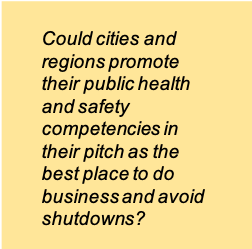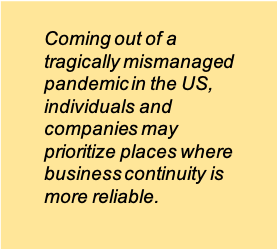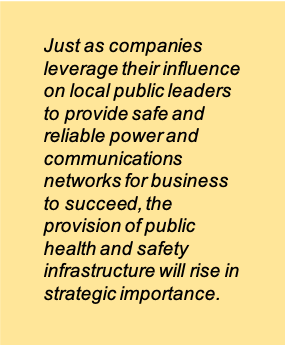ECONOMIC GEOGRAPHY AND THE POST-COVID WORLD: What does the current pandemic mean for the value of place? What are the implications for places like Silicon Valley?
By Tracey Grose, originally published on Medium August 7, 2020
Decoupled from work, geography takes on new meaning. As companies around the world move to remote work in response to the global pandemic, people are resettling in suburban and rural areas far away from their employers. Does place still matter?
Six months into the crisis, it has become clear that some countries and US states have handled the pandemic better than others. Could cities and regions promote their public health and safety competencies in their pitch as the best place to do business and avoid shutdowns? Well run communities that invest in crisis prevention and response and that pursue evidence-based public policy will be better able to weather crises and mitigate negative economic impacts.
Disruption speeds change. History is instructive in reminding us how rapid and fundamental change can be and also how we can avoid repeating tragedies of the past. What we know from monumental events in history is that nothing goes back to the way it was before. Pandemic, war, social movements and transformative technology can leave us scrambling for our lives and livelihoods.
For example, the invention of the internet (World Wide Web) in 1989, through the combined efforts of the Federal government and the private sector, revolutionized the worlds of communications, computers, collaboration, and commerce. Entirely new companies and business models quickly appeared, and existing industry sectors were forced to rapidly adapt or die as consumer behavior shifted online.

Today, the sudden pivot to remote work due to the pandemic is speeding digital transformation across all sectors and especially in health care.
Vision is vital for pushing forward through the whirlwinds of change to come out in a stronger position than before. In periods of great disruption, the best stance is a proactive one. Having a clear vision for our desired outcomes will help guide the steps – large and small – in a rapidly shifting terrain.
Does Place Still Matter?
Silicon Valley’s development into the world’s most vibrant and resilient innovation hub was driven by many factors:
- A high concentration of public and private labs and research universities as well as strong flows of Federal research funding
- A strong flow of talent from around the world to universities and companies in the region
- A high concentration of venture capitalists with a preference for investing in startup companies close to home
- Dense networks of informal relationships based on shared affinities, passion for technological discovery and trust
- A relatively open and flexible corporate culture and fluid labor market that enabled greater collaboration and the freer flow of knowledge
- A deep mix of diverse technology sectors, enabling opportunities for technology convergence and the creation of new products and markets
- An attractive location with a mild climate allowing for year-round outdoor activities and with world-class dining and cultural offerings.
People have come to Silicon Valley to join its vibrant ecosystem in which serendipitous encounters can flip fortunes, and talented teams can quickly assemble and disperse in the constant churning of the dynamics of creative destruction. The region’s openness also enabled talented immigrants to put down roots, found companies and drive innovation in the region while also building networks of partners and supply chains in their home countries. Silicon Valley in its form today, was birthed from the physical convergence of people, cash and creation.
How will COVID-19 reshape Silicon Valley and its relevance in the global innovation economy?
The COVID Crash and Dash
With the current pandemic, cities around the world have witnessed an exodus to the suburbs and countryside. Looking to stretch their funding, many startups in the Bay Area have given up their offices, and teams have dispersed across the country and abroad. According to a recent survey by Hired, 47% of Bay Area tech workers considering a move are looking for a lower-cost location. This survey also reported that 53% of Bay Area tech workers expect to be furloughed in the next six months. The Bay Area has a high concentration of engineering, scientific, creative and business talent born abroad, so much of its workforce has options outside the US.
Of course, not all work can be done from home. While we often lurch into black-and-white thinking when jolted by disruption, the future is always a blending of old and new. Population-serving sectors including essential health and retail workers are place based. We also still need to make things. Agriculture, manufacturing and research labs, for example, all require people to come together at specific locations with the necessary equipment to complete tasks together. Although advances in 3D-printing and urban farming are presenting new plausible scenarios for how we will produce the things we need.
As offices presently stand empty, and people move away in search of affordable housing and more space for their children, what will places like San Francisco and Sunnyvale look like a year from now?
Will COVID Define a new Regional Comparative Advantage?
If location is no longer a constraining factor in how you earn a living and the trajectory of your career, the considerations you weigh for where you wish to live can be very different. If you can work from anywhere, you might choose adventure in Costa Rica or proximity to family in the Heartland.
After more than six months, it is now clear that some countries have handled the pandemic far better than others. Clear-eyed leadership, evidence-based public policy, and a national healthcare system that leaves no one out (thereby reducing risk and costs for everyone) are key factors behind mitigating human suffering, death and economic shutdown.
Coming out of a tragically mismanaged pandemic in
the US, individuals and companies may prioritize places where business
continuity is more reliable. Whether it be the next town, state or a different
country entirely, the current crisis is laying bare both the egregiously
fragile and the well managed communities.

Economic development agencies are wasting no time as talented workers scatter geographically. Places like Savannah, Georgia, Costa Rica, and the Bahamas are advertising themselves as the ideal location for remote workers. However, as COVID cases spiked in the US, the Bahamas acted to protect its appeal by banning all commercial flights to and from the US.
A well-managed community can have strong appeal. For places vying to become havens for remote workers, it will be in their best interest to demonstrate they can protect their communities and therefore also manage dangerous misinformation and anti-social behavior (e.g. mask protests).
Could cities and regions start promoting their public health and safety competencies to attract new remote workers and businesses? If a public health crisis is well managed from the start, an economic shut down will be less necessary. There’s nothing like a pandemic to vividly demonstrate the value of evidence-based public policy over ideologically-driven magical thinking.
What will the post-COVID economic geography mean for global competitiveness?
As technology and the global economy have evolved hand-in-hand over time, the key factors of economic competitiveness have evolved as well.
In the industrial economy, success was determined by access to natural resources and mass labor. Vertically integrated companies relied on centralized control to produce large volumes of standardized goods.
In contrast, the innovation economy has been characterized by networks of smaller-scale, specialized partners and access to a highly skilled workforce. As a result of advances in digital design technology, processing speeds, storage capacity, and production technology, the model has shifted from mass production to mass customization. Success has been determined largely by a company’s speed to market and flexibility to market shifts.
In a post-COVID economy, success will be determined by the ability to withstand and adapt to major shocks resulting from a variety of sources including financial, geopolitical and public health crises. Scientists warn that the risk of infectious disease transmission is rising with the growing impacts of climate change and increasing encroachment of human population centers on pristine natural habitats.
Going forward, the economic success of a company and population in the post-COVID world will require new emphasis on factors of collective action and investment, such as:
- Clear-headed, accountable public leadership focused on cultivating the resilience and wellbeing of the population
- Private sector leadership (and supportive shareholders) that demonstrate a holistic perspective, understanding that the success of the company relies on the wellbeing of the community
- Healthcare systems that leave no one behind, thereby reducing risk for everyone
- Education systems that impart meaningful skills in a framework of life-long learning and also impart the shared values necessary for cultivating an inclusive and prosperous society
- Strong environmental stewardship and climate action to safeguard health, property and civilization
Public Health and Safety Leadership: The New attractors for talent and investment?
Communities are suffering from great uncertainty and the physical threat of a killer virus that is running rampant across the US largely because of the willful negligence of a highly politicized and ineffective White House (the likes of which we have never seen before).
A city, state or country that enables wide-spread despair among its population, will sow fragility and drag throughout the system. Such a place will have significant difficulty weathering major shocks such as an epidemic or financial crisis.
Going forward, people (especially working parents!) and business will demand more of their public leaders and communities. Just as companies leverage their influence on local public leaders to provide safe and reliable power and communications networks for business to succeed, the provision of public health and safety infrastructure will rise in strategic importance. It is in everyone’s best interest for ensuring a vital economy and community. Geographically untethered, people can now go anywhere. It is always the individuals with the most financial means who also have the greatest breadth of choice to exit a failing system, such as a failing school or even a country captured by incompetent leadership.

Places that demonstrate a highly functional, safe, civil and prosperous community will become strong magnets for global talent and investment. This has potential for a strong economic boon which could drive continued investment in crisis management and business continuity. (New Zealand, anybody?)
If geography is taking on new meaning, what can we do to cultivate thriving, resilient places? We can start by clarifying the vision for the future we desire so that we can push forward through the whirlwinds of change to come out in a stronger position than before.
Developing a robust social infrastructure lends flexibility and adaptability to a constantly changing economy. It reflects the systemic nature of society and sets into motion the self-reinforcing positive dynamics that strengthen the system as a whole. Such a robust social infrastructure can cultivate greater resilience to change and shared prosperity.

